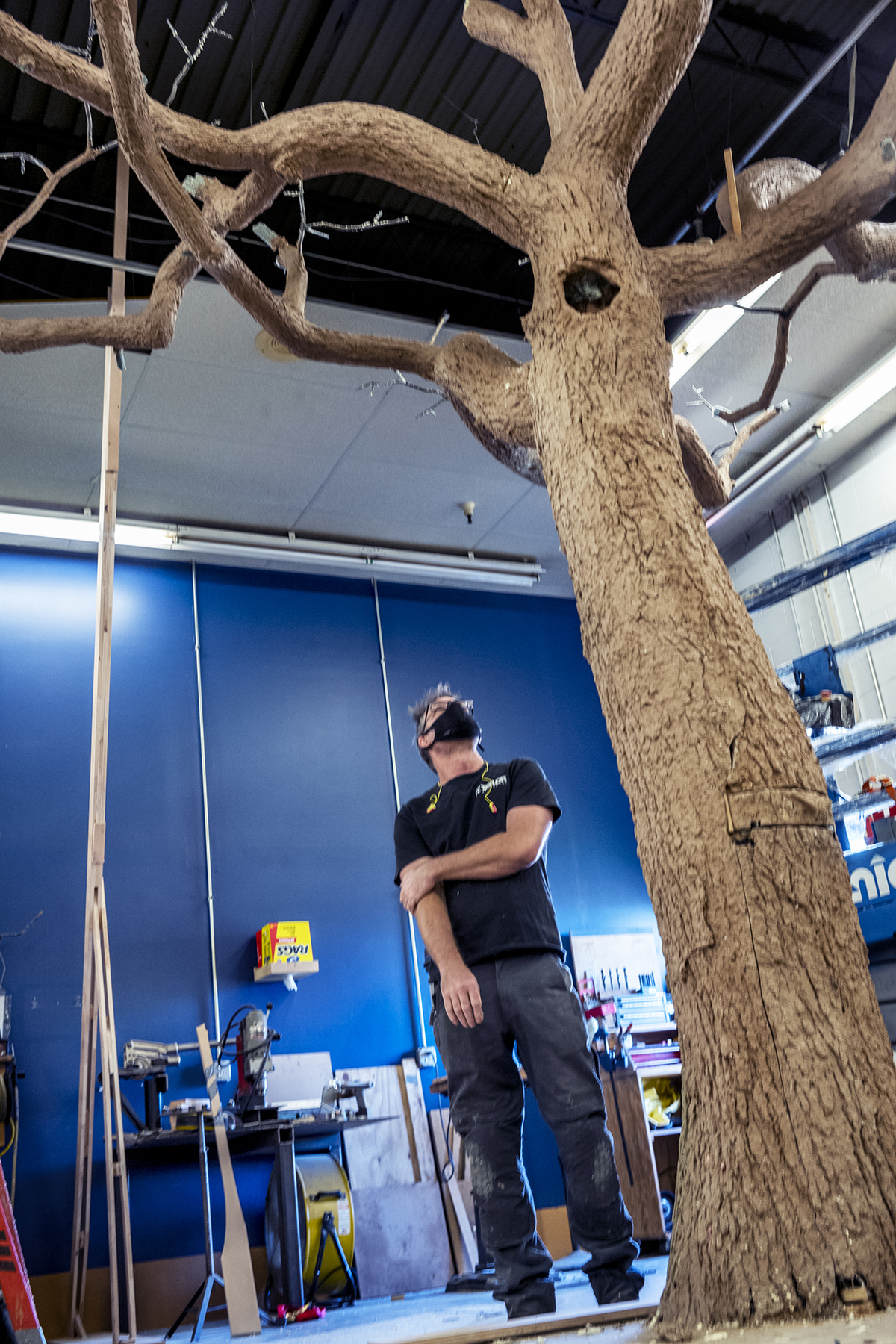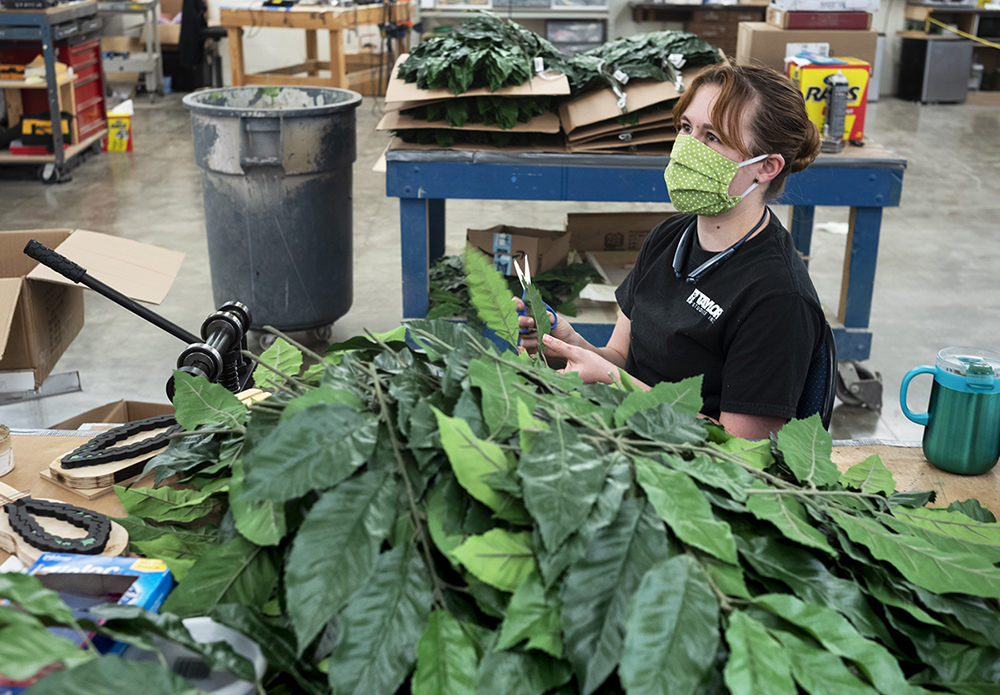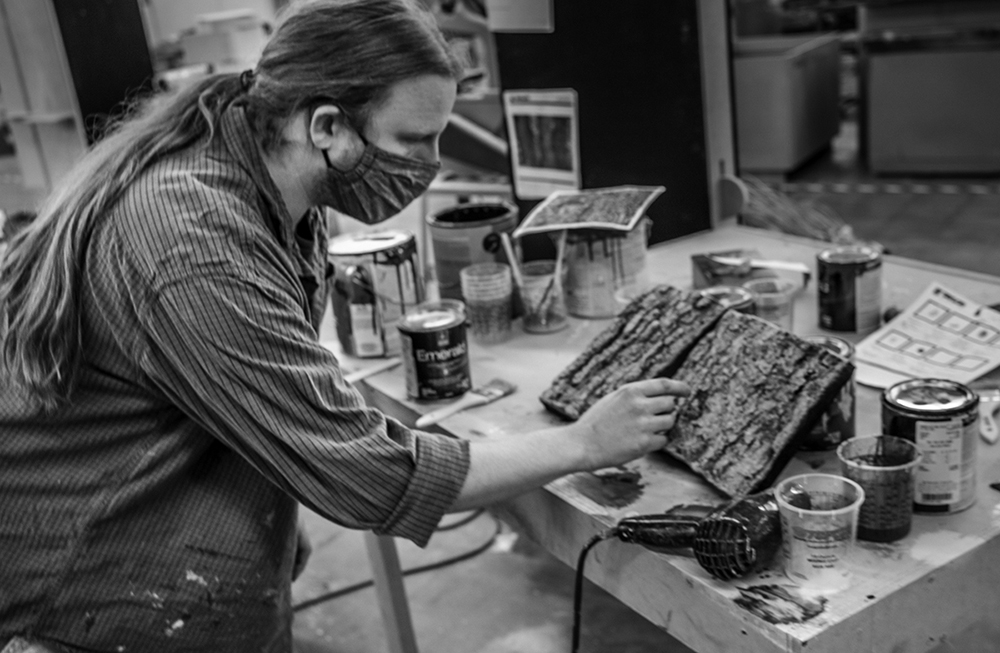
Sculptor Shawn Hensley pauses to assess his work on an 18-foot model of a Chinquapin Oak tree that will be erected in Forest Park Nature Center. Hensley said this will be the largest tree he’s created. (PHOTO BY DAVID ZALAZNIK)
To know the Chinquapin Oak is to know something about our region’s ecological history and our own ecological geneology.
Chinquapins are hallmark trees of the Central Illinois River Bluff. Slow growing with dense wood and a gray-brown bark, the tree lacks the flashiness of maples ablaze in autumn or the misty white flowers of serviceberries in spring.
It is a quiet sentry with a vast knowledge of the environment.
Often called the Redwoods of our region, an 18-foot tall model of a Chinquapin will greet visitors at the newly remodeled display at Forest Park Nature Center. This is a majestic and often-abused tree that helps us understand our mistakes, our ecology and ourselves.
With a $250,000 state grant, the display area at Forest Park Nature Center is getting its first update in half a century. The new exhibit is not so much geared toward itemizing what can be found in nature but geared for helping visitors understand the interconnections and complex ecology of the Peoria River Bluffs.
Dale Goodner, former naturalist with Peoria Park District, said the Chinquapin is in the family of white oaks and can be found on south facing hill prairies. Once a dominant tree in our region, the Chinquapin is threatened by development and invasive species like maple, sassafras and ash.
The once plentiful trees were lumbered, stacked along the river and used for railroad ties.
“Listen and the Chinquapin is telling us something. Chinquapin is the poster child for the need for restoration ecology. It’s the infrastructure of ecology, the spirit of our region. It’s a gorgeous tree,” Goodner said.
He quoted former Wisconsin governor and senator Gaylord Nelson who said, “Nuclear war is not inevitable, but major degradation of our environment with grave consequences is inevitable unless we reverse the trend.”
Goodner said we have already lost 90% of the infrastructure of our ecology, but it’s not too late. Key to restoration ecology in our region is the oak, host to birds, butterflies, a myriad of insects and wildlife.
The Chinquapin model destined for Forest Park Nature Center is in the final stages of construction at Taylor Studios in Rantoul. One artist is at work on the leaves, another on the bark and another on the basic structure of the tree. Installation in Peoria is scheduled for May.

Brittany Norman cuts leaves for the realistic model of a Chinquapin Oak tree that will look like it’s growing inside the Forest Park Nature Center display area. The tree will have about 5,000 leaves. (PHOTO BY DAVID ZALAZNIK)
Brant Hendricks, production manager at Taylor Studios, said the company has produced models and exhibitions for locations across the United States, Canada and worldwide. Housed in a 64,000-square-foot former WalMart store, every section of the space is being used for production, fabrication and design projects. One project is a two-story stack of books destined for a library in Florida. A duplicate model in the studio is of a signal man on the U.S.S. Midway Museum in San Diego. Another recent project was a 35-foot rock face with birds for a display in Iceland.
“The Chinquapin is highly realistic. It will look like it’s growing out of the floor,” Hendricks said.
Chief naturalist at Forest Park Nature Center Kristi Shoemaker said it took years of planning to get to this point in the renovation.
“We’d like visitors to gain an appreciation of nature and feel empowered to protect our area and our watershed. We will give them the tools to understand what is needed and to be inspired to care.”
Hensley, the artist working on the model, grew up in Tucson, Ariz., inspired by the Saguaro cactus. He earned his degree in sculpting at the University of Arizona in Tucson.
“This work has changed my appreciation of the Chinquapin,” he said. “It’s a special tree. Each tree is really an individual and has a special, individual story to tell.”

In the expansive 64,000-square-foot Taylor Studio space, J McDowell works from photos to create a color wash for the bark on the Chinquapin Oak. He tries to keep the different colors to a minimum and layers them on for a realistic look for the tree bark. (PHOTO BY DAVID ZALAZNIK)
